Is Qantas or Velocity Status Harder to Earn in 2025?
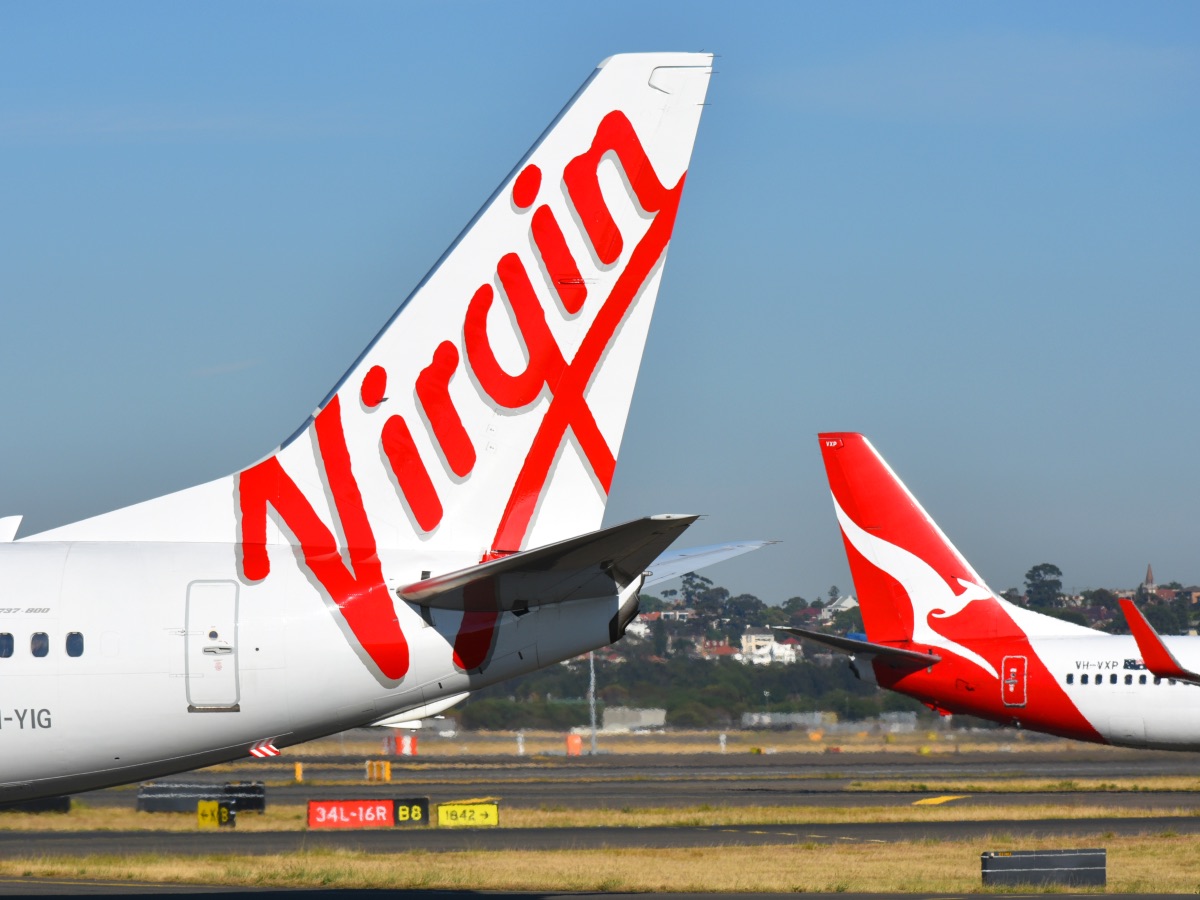
Velocity Frequent Flyer recently implemented major changes to the way its members earn status. Velocity now ties status credits directly to the amount of money you spend on tickets. It also requires you to earn at least half of the required status credits from Virgin Australia marketed or operated flights.
These changes make it harder and more expensive for many Virgin flyers to earn or maintain their status, compared to Velocity’s old system. But Velocity Frequent Flyer still believes it’s much easier for its members to earn status, compared to Qantas.
Based on its internal modelling, Velocity believes it’s still 3-3.5x more cost-effective for Australians to earn status with Virgin Australia than with Qantas. It says that its members can obtain Gold status faster than with Qantas on an equivalent level of domestic flying.

This claim is at odds with the perception that Velocity status is now much harder to earn. As many Australian frequent flyers also regard Qantas status as more valuable than Virgin status, due to Qantas’ Oneworld alliance membership, international lounges and much larger network, some ex-Virgin loyalists say they are now considering switching to Qantas.
So, who’s right? In 2025 and beyond, does it actually cost three times as much to earn Qantas status, compared to Virgin Australia status? To answer this question, our independent frequent flyer program experts crunched the numbers…
How many status credits you need to earn Qantas & Velocity status
The first thing to consider is the number of status credits needed to earn each of the status tiers within the Qantas Frequent Flyer and Virgin Australia Velocity programs.
To earn or renew Qantas status, you’d need the following amounts of status credits (plus take at least 4 Qantas or Jetstar flights) within your membership year:
| Qantas tier | Silver | Gold | Platinum | Platinum One |
|---|---|---|---|---|
| Annual status credits to earn | 300 | 700 | 1,400 | 3,600 (at least 2,700 from QF flights) |
| Annual status credits to renew | 250 | 600 | 1,200 | 3,600 (at least 2,700 from QF flights) |
And to earn or renew Virgin Australia Velocity status, you’d need to earn the following amounts of status credits within a 12-month period (with at least 50% coming from VA flights):
| Velocity tier | Silver | Gold | Platinum | Platinum Plus |
|---|---|---|---|---|
| Annual status credits to earn | 250 | 500 | 1,000 | 2,000 (at least 1,500 from VA flights) |
| Annual status credits to renew | 200 | 400 | 800 | 2,000 (at least 1,500 from VA flights) |
On the surface, these tables make it look like Qantas status is around 20-80% harder to earn than Velocity status, as that’s the number of additional status credits that Qantas requires for its equivalent tiers.
But that’s not a fair comparison because the status credit earn rates with both programs are different. Velocity’s 50% VA flight requirement is also a lot more onerous than Qantas’ requirement to simply take 4 Qantas or Jetstar flights each year (except for Platinum One status).
Velocity’s spend-based vs Qantas’ flight-based status credit earn
Since Velocity now awards 1 status credit per $12 spent on domestic and short-haul international flights (except Economy Lite fares, which earn at half that rate), it’s quite hard to “game” Velocity status.
You can earn up to 50% of the required status credits from family pooling, Flybuys, credit cards or partner airlines. But Velocity has just reduced the status credits you’ll earn on partner airlines, and there are limits to the amount of status credits you can earn from Flybuys or credit cards.
And you’ll still need to get at least half of your status credits from Virgin Australia marketed or operated flights that you personally fly. This also makes it impossible to earn Velocity status if you only fly Premium Economy or First Class, since you cannot book either of those cabins on a VA flight number.
Basically, this means the amount of spend required to earn Velocity status is now relatively fixed. In some cases, you can still find ways to earn status credits for less than $12 each. But almost all of the Velocity partner airline flights that we looked at when researching for this article earned at a rate worse than $12 per status credit.
When earning status credits from Virgin Australia flights, the actual cost per status credit is actually slightly less than $12 each because Velocity rounds up the ticket price (for the purpose of awarding status credits) to the nearest $12. On average, the actual cost per status credit for the domestic flights we looked at was around $11.60.

By comparison, Qantas awards status credits based on your fare class and the distance you fly. In some cases, this can very much work to your advantage. But it also means that you earn a relatively low rate of status credits on short but expensive flights.
As a result, there’s a much wider variation in the cost of earning Qantas status, depending on your travel patterns and how well you can “game” the system. (Some critics may argue that people gaming the system is unfair, but I would argue that this “gamification” is also one of the things that makes Qantas Frequent Flyer such an appealing program!)
Bonus status credit offers
Both Qantas and Velocity Frequent Flyer tend to offer double status credits a couple of times per year, during special promotions. Velocity has even offered triple status credits a couple of times.
If you book your flights during these promotional periods, you can obviously reduce the amount of flying and spend needed to earn status with either airline. But for the purposes of this analysis, we’ve assumed that all status credits are earned at the regular rates.
So, which program offers an easier pathway to status?
With all of this in mind: Does Qantas or Virgin Australia make it easier to earn status in 2025?
In truth, it really depends on what your travel patterns look like. So, to answer this question, we calculated the minimum amount of money that 12 different types of travellers with different travel patterns would typically need to spend to reach each of Qantas and Velocity’s four status tiers.
These are the 12 different travel profiles that we considered for our analysis:
| Type of traveller | Travel profile |
|---|---|
| The regional flyer | Flies Economy on regional domestic routes such as ASP-BNE, BNE-EMD, ASP-ADL & PER-KGI |
| The domestic Economy corporate traveller | Based in Sydney and flies on Economy Flex fares to domestic destinations like BNE, ADL, PER, CBR, HBA & MEL |
| The “First Class to London” flyer | Just flies First Class from Sydney to London |
| The Premium Economy flyer | Based in Sydney and flies Premium Economy to international destinations like AKL, SIN, LAX & LHR |
| The international Business traveller | Based in Perth and flies Business Class to international destinations like SIN, JNB, CDG & SFO |
| The politician | Based in Canberra and flies a mix of Economy Flex & Business to all other Australian state & territory capital cities |
| The Melbourne-Sydney commuter | Stuck on the MEL-SYD monorail; booked on Economy Red e-Deal or Choice fares every time |
| The international Economy traveller | Based in Perth and flies Economy to SIN, LHR & LAX |
| The domestic Business flyer | Based in Sydney and flies Business Class to domestic destinations like BNE, ADL, PER, CBR, HBA & MEL |
| The trans-Tasman flyer | Flies a mix of routes between Australia & New Zealand in a mix of Economy & Business Class |
| The holidaying family | Based in Brisbane and flies Economy to NAN, DPS & CNS |
| The status runner | Earns status credits in the absolute cheapest way possible, using a mix of good value status runs |
For each of these traveller profiles, we calculated that you’d need to spend approximately the following amounts of money to reach each tier with Qantas and Velocity:
Minimum spend to earn Silver status
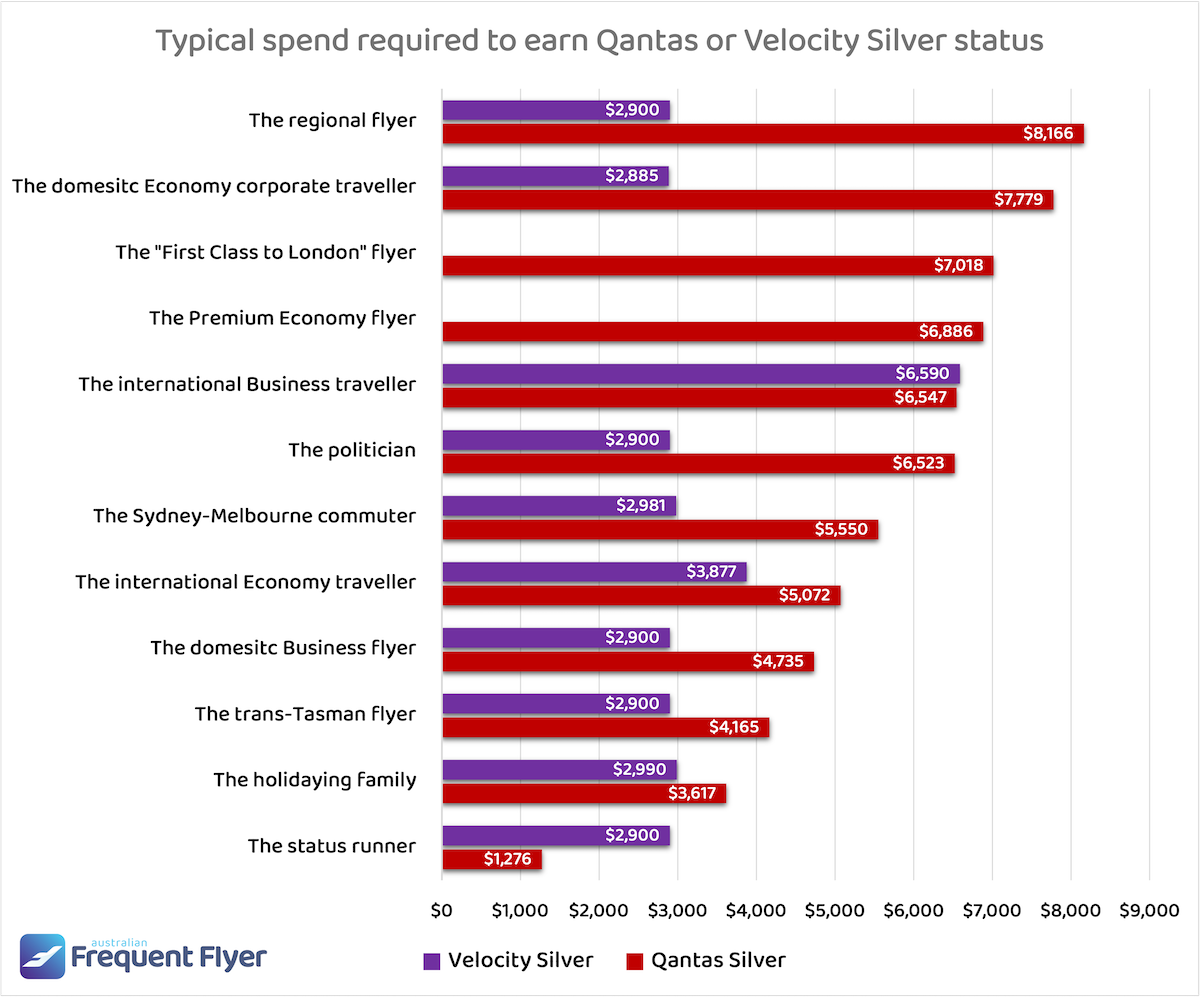
As you can see, the cost to earn Velocity status is much more consistent than with Qantas between the different traveller profiles. However, the cost per Velocity status credit on international long-haul flights is much higher than for Virgin domestic flights.
Note that there are no values shown for Velocity on the First Class and Premium Economy traveller profiles, since it would be impossible for these travellers to earn Velocity status.
Minimum spend to earn Gold status
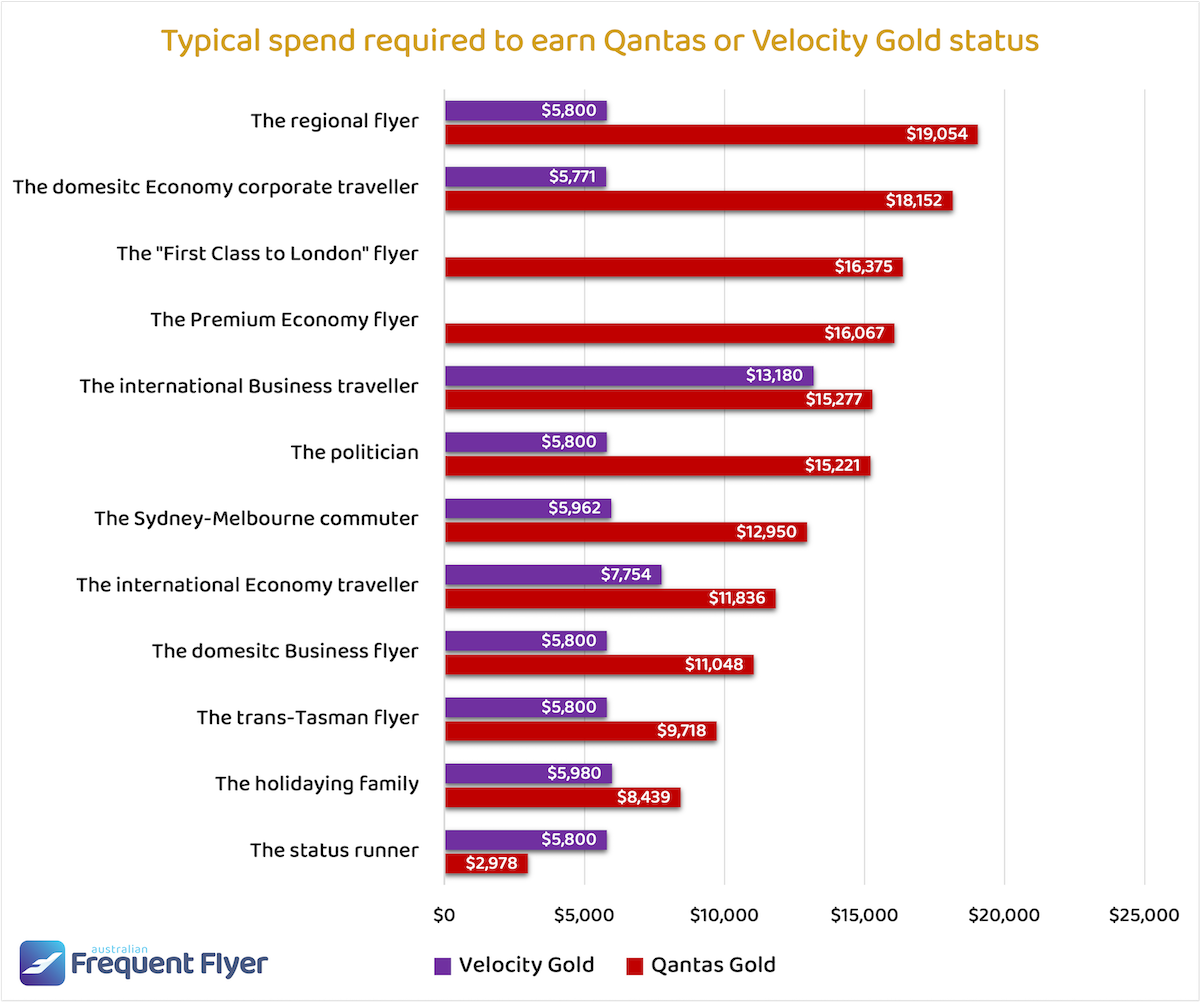
Minimum spend to earn Platinum status
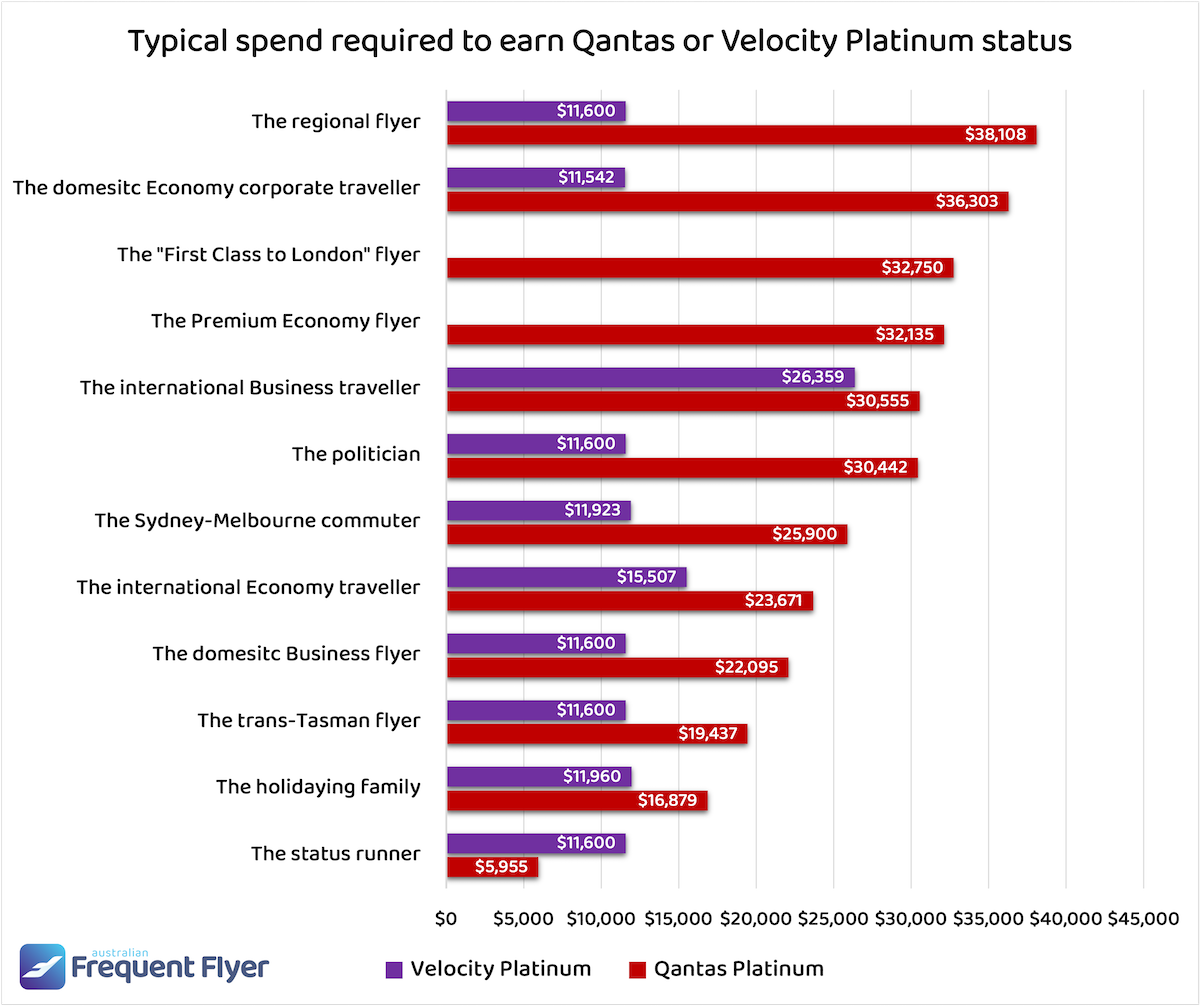
Required spend to earn Platinum One or Platinum Plus status
For this analysis, we’ve taken into account the fact that a flyer would need to earn at least 75% of status credits on Qantas or Virgin Australia flights.
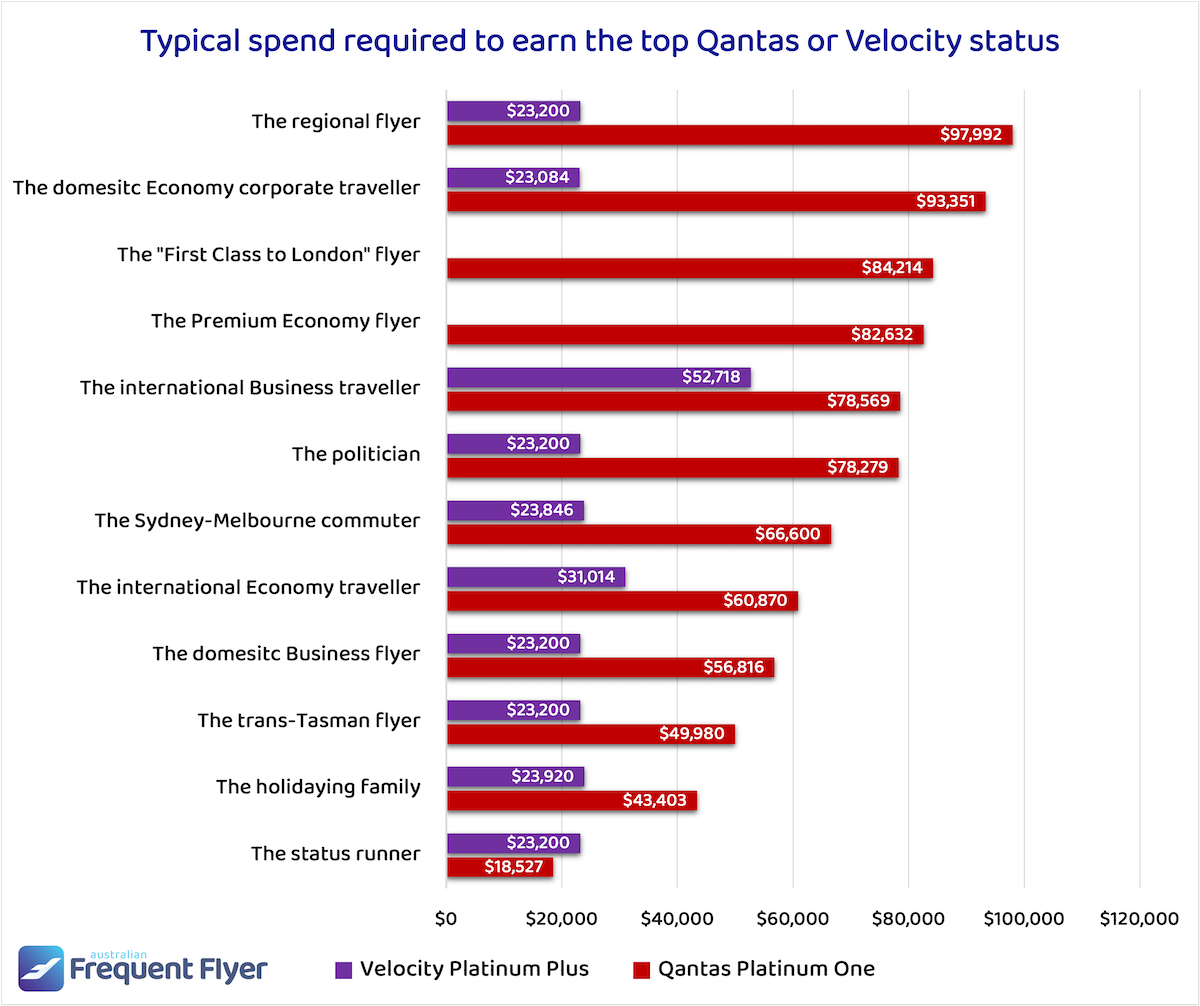
Overall average spend to earn Qantas vs Virgin status
As you can see, the cost to earn Qantas status varies considerably depending on the types of flights you book. So, as a final point of comparison, we calculated the typical average spend required to earn each of the Velocity and Qantas status tiers for someone flying a mix of all the different types of flights we considered in our above analysis:
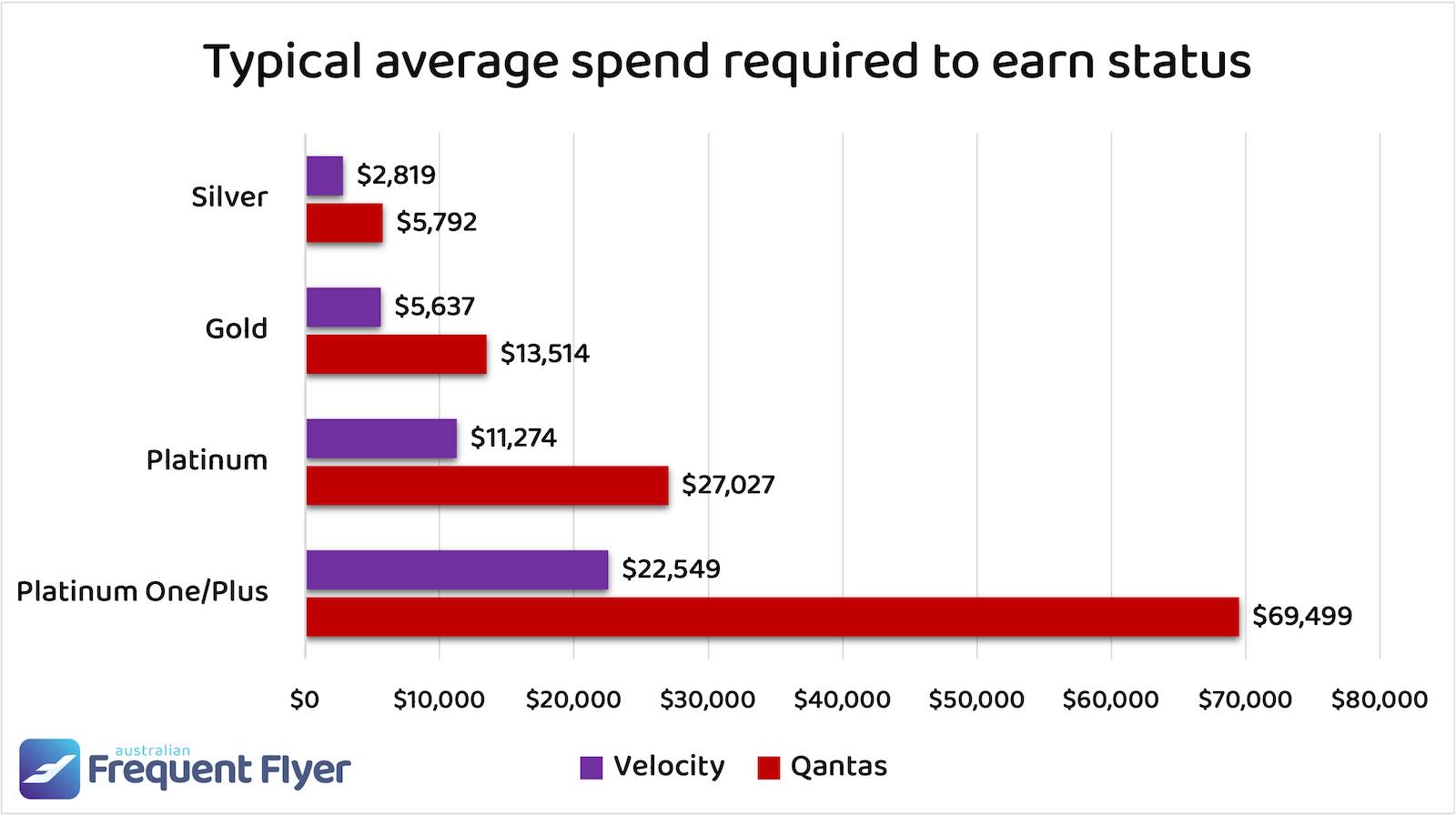
Qantas status typically costs 2-3x more to earn
Our modelling shows that Qantas status typically costs around 2-3x more to earn than Velocity status, under the latter program’s new earning model.
But there’s a big catch.
If you’re earning Qantas status credits in the most cost-effective way possible, it can now be much cheaper to earn status with Qantas than with Virgin Australia. That’s because it’s still possible to game the Qantas program by booking “status runs” that maximise the status credits earned, relative to the cost.
There’s probably a sizeable chunk of the AFF community that does exactly this. For these people, Qantas status might indeed now be easier to earn. But this probably doesn’t reflect the broader travel patterns of the general public!
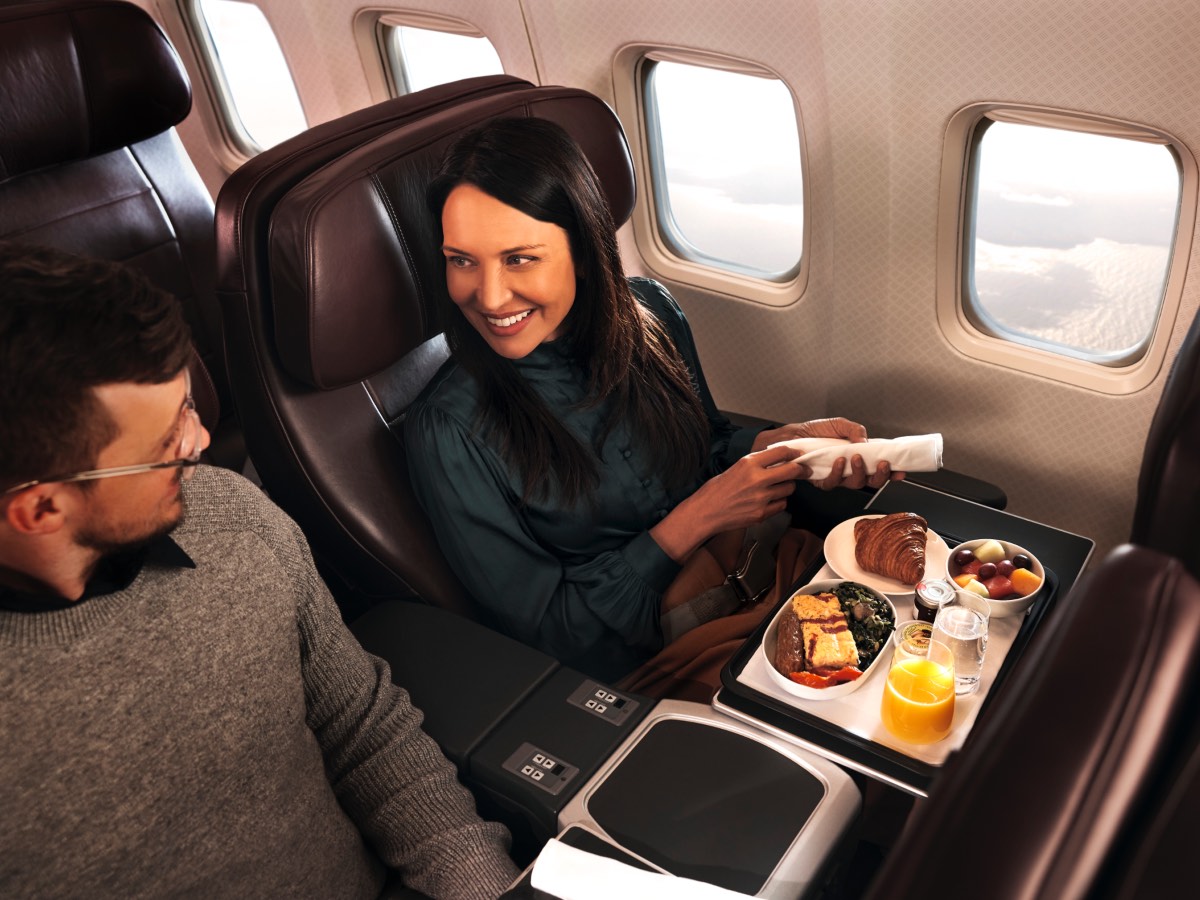
What about the number of flights needed to earn status?
So far, our analysis has just compared the amount of money you’d need to spend to earn status. But what about the amount of flying required?
Well, it really depends on how expensive the tickets you’re buying on Virgin Australia would be. Under Virgin’s new model for earning status credits, booking cheaper flights means you’d need to take a lot more of them to earn status.
When researching this article, we found that Virgin’s typical advance-purchase Economy Choice fare on the Melbourne-Sydney route was around $155 one-way. Qantas’ lead-in Economy Red e-Deal fare on the same route was $185.
If we base our calculations on these numbers, a Virgin Australia flyer would need to take 39 one-way Economy Choice flights between Melbourne and Sydney to get Velocity Gold status. If booking Economy Flex tickets on Virgin, that would reduce to 28 one-way Melbourne-Sydney flights.
By comparison, you’d need to take 70 one-way Qantas Red e-Deal flights on the same route to earn Qantas Gold status. If booking Economy Flex fares on Qantas, that number halves to 35 flights.
One final thing: the “holidaying family” flying to Fiji, Bali and Cairns could absolutely still take advantage of Velocity’s family pooling to reach status faster. When flying as a family, one of the adults in the household can still collect all the status credits of the other family members. However, only up to 50% of those status credits can now be counted towards the main flyer’s status.
Enjoy Virgin Australia Lounge access and a complimentary annual return domestic flight…
- Card Name
- American Express Velocity Platinum – 60,000 bonus Velocity Points*
- Earn
- 1.25
- Signup Bonus
-
60,000 bonus Velocity Points*
- Annual Fee
- $440 p.a.
- Read more
- View Offer
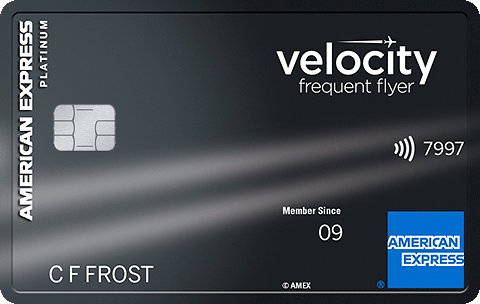
Velocity Points on everyday purchases
What does this tell us?
Our analysis finds that, for most people, Velocity status is still easier to earn than Qantas status. This is particularly the case if a lot of your flying is on relatively expensive domestic tickets.
That said, by earning your status credits wisely, it is possible to earn Qantas status at a lower cost than Velocity status.
Of course, this doesn’t account for the difference in the benefits between Velocity and Qantas status. Many frequent flyers consider Qantas status to be more valuable, especially those who fly overseas a lot.
If a lot of your flying is international, you might also want to consider that trying to stick to Virgin’s international partner airline network could be a bit limiting. In our analysis, we looked at routes served by both Qantas and Virgin (or on their partner airlines). But if you fly a lot to South America, for example, Velocity status really isn’t very useful there. And booking codeshare flights on Virgin’s partner airlines – which you might have to do to meet the 50% VA flights requirement – comes with its own issues.



Community Comments
Loading new replies...
Join the full discussion at the Australian Frequent Flyer →